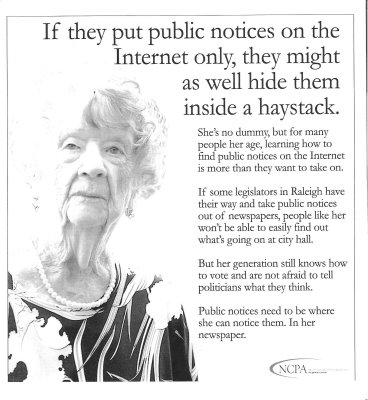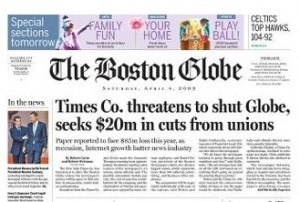We’re back from filing an 80,000-word manuscript for a book about using billions of dollars worth of high-tech satellite equipment to find Tupperware in the woods. Really. And not much has changed in the last 10 days.
Murdoch Now Struggles Online
Rupert Murdoch was hailed as a visionary when he paid the then-bargain price of $580 million for MySpace in 2005, but now it appears that the newspaper mogul may not know that much about running an Internet community after all. MySpace just laid off 400 employees in the US and could cut another 100 internationally. That would amount to more than 15% of the company’s 3,000-employee workforce.
Crain’s New York quotes eMarketer forecasting a 15% drop in MySpace ad revenue this year, while Facebook is expected to gain 10%. MySpace is still bigger, but it’s headed in the wrong direction, with a 2% decline in visitors in April, compared to an 89% gain at Facebook. Murdoch has fired some executives and promised to rejuvenate MySpace, but the site has lost its utility to the older audience, which is flocking to Facebook. MySpace is still the preferred destination for rock bands and entertainment companies, but that doesn’t give it much cachet with the wealthier audience that Facebook is attracting.
Post Publisher Just an Ordinary Mom
 Vogue has a feature on Katharine Weymouth, publisher of the Washington Post and granddaughter of the revered Katharine Graham. Nancy Hass portrays Weymouth as an unpretentious, down to earth mother of three who just happens to run one of the world’s most prominent media properties. “She’s a mother first,” says her friend Molly Elkin, a labor lawyer.
Vogue has a feature on Katharine Weymouth, publisher of the Washington Post and granddaughter of the revered Katharine Graham. Nancy Hass portrays Weymouth as an unpretentious, down to earth mother of three who just happens to run one of the world’s most prominent media properties. “She’s a mother first,” says her friend Molly Elkin, a labor lawyer.
The Post‘s new managing editor, Marcus Brauchli, calls Weymouth “an amazing listener” who isn’t afraid of criticism and who seems more at home with her people that the glitterati. She moved her office off the Post‘s executive floor and down into the advertising department, where she easily banters with her employees. Her home is a modest four-bedroom affair in Chevy Chase, where she greets visitors amid the barely controlled chaos of a living room full of toys.
Although she faces a huge task in reinvigorating a paper whose circulation has dropped 20% since its heyday, she says she has no grand plan. In fact, the piece makes out Weymouth to be a smart (Harvard magna cum laud and Stanford Law) achiever who makes it up as she goes along. Her attitude toward the Huffington Post and The Daily Beast, which both use Post content without paying: “Good for them. All’s fair, you know.”
Miscellany
The Associated Press is struggling to change its business model in light of the collapsing fortunes of the newspaper industry. The cooperative is trying to negotiate more lucrative licensing deals from major Internet news sites while cutting prices to newspapers in an effort to prop them up. The AP will reduce fees by $45 million for newspapers and broadcasters next year, or about $10 million more than the rate cut it announced in April, CEO Tom Curley said earlier this week. But that won’t stop the decline in revenue, which is expected to continue through at least next year. Curley said the AP aims to reduce its 4,100-person workforce by 10% through attrition, but that layoffs may be necessary.
After 18 months on the market, the Portland (Me.) Press Herald finally has a new owner who has promised to reinvigorate the troubled paper and restore it to profitability by the end of the year. Bangor native Richard Connor officially took the helm this week and said readers will immediately notice a thicker paper and better integration with the website. But there will be pain, with layoffs of up to 100 employees likely. Remaining employees will get a percentage of the operation and two seats on the board. A conciliatory Guild executive said the layoffs will prevent much bigger job losses that would have occurred if the Press Herald had gone under.
The Knight Foundation is funding nine new-media projects to the tune of $5.1 million. The biggest winner is DocumentCloud, a project conceived by journalists from The New York Times and ProPublica to create a set of open standards for sharing documents. Other projects receiving support include one to help citizens use cell phones to report and distribute news, an effort to develop a media toolkit for developing mobile applications and an online space where the people can report and track errors in the media.
Yahoo’s Newspaper Consortium continues to be a bright spot for the industry. Yahoo reported that five new members just joined the ad-sharing cooperative: the Orange County Register, Colorado Springs Gazette, North Jersey’s Record and Herald News and the San Diego Union-Tribune. The group’s 814 newspaper members account for 51 percent of all Sunday circulation in the US.
Newspaper Guild members at the Albany Times Union have rejected a management proposal that would have eliminated seniority considerations in layoffs and permitted outsourcing of Guild jobs. The vote was 125 to 35. No word on whether the parties will return to the bargaining table, where they have been deadlocked for nine months.
Dan Gillmor has a short, pointed piece on MediaShift pleading for an end to caterwauling over the future of journalism and praising the “messy” process that is going on. “I’ve grown more and more certain that we will not lack for a supply of quality news and information,” provided that risk-takers are permitted to experiment and that the supply of people who want to practice quality journalism doesn’t dry up, he writes. Like Clay Shirky, Gillmor believes experimentation will ultimately lead to many smaller news operations replacing a few big ones, and that that’s not a bad thing.


 The New York Times Company shocked the newspaper industry last week with its threats close the Boston Globe on May 1 unless Globe unions give back $20 million in concessions. There’s new evidence that the May 1 date is a bluff and that closing down the Globe could cost the Times more than keeping it in business.
The New York Times Company shocked the newspaper industry last week with its threats close the Boston Globe on May 1 unless Globe unions give back $20 million in concessions. There’s new evidence that the May 1 date is a bluff and that closing down the Globe could cost the Times more than keeping it in business. The Herald’s rapacious columnist, Howie Carr (left),
The Herald’s rapacious columnist, Howie Carr (left),  Vanity Fair uses a lot of words to describe Arthur Ochs Sulzberger Jr. in
Vanity Fair uses a lot of words to describe Arthur Ochs Sulzberger Jr. in 


 Amid all the hand-wringing about the lack of new-media alternatives to newspapers, the online-only
Amid all the hand-wringing about the lack of new-media alternatives to newspapers, the online-only  John Yemma would probably agree. As his publication, the Christian Science Monitor, goes Web-mostly, the editor (right) has launched a blog that he hopes will be “a place to talk about the changes in media.” In his second entry,
John Yemma would probably agree. As his publication, the Christian Science Monitor, goes Web-mostly, the editor (right) has launched a blog that he hopes will be “a place to talk about the changes in media.” In his second entry, 


 It depends on the location. Areas of Europe that are well wired for the Internet and have robust wireless infrastructures, like the Nordic region, will probably see the need for newspapers decline more quickly than those that charge high fees for Internet access or do not have affluent populations. Eastern Europe, in contrast, will probably be a fairly robust market for newspapers for some time. Some cultures are also more invested in the newspaper model, as is the case in the UK. In general, Europe will discard print newspapers more slowly than the US because traditions are more embedded and, in some cases, government subsidies will keep print publications afloat. France is an example of that.
It depends on the location. Areas of Europe that are well wired for the Internet and have robust wireless infrastructures, like the Nordic region, will probably see the need for newspapers decline more quickly than those that charge high fees for Internet access or do not have affluent populations. Eastern Europe, in contrast, will probably be a fairly robust market for newspapers for some time. Some cultures are also more invested in the newspaper model, as is the case in the UK. In general, Europe will discard print newspapers more slowly than the US because traditions are more embedded and, in some cases, government subsidies will keep print publications afloat. France is an example of that.


